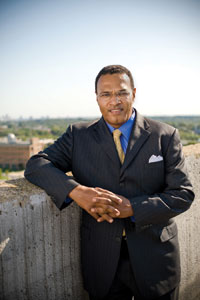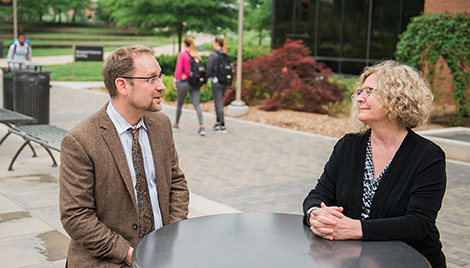UMBC President Freeman A. Hrabowski, III, takes your questions.
The powerful connection between research and teaching has been a foundation to UMBC’s success. Why is this vital link so important to the university community? What makes this relationship special at UMBC?
– Richard Byrne ’86, English
When I talk with students and parents, or with donors, or with legislators about the uniqueness of UMBC, I invariably address the relationship between research and teaching at the university.
People often want to know why research universities expect their faculty to teach fewer courses than faculty at comprehensive institutions or community colleges. Parents often want to know if research faculty actually work with students, and what advantages there are for undergraduates who attend a research university. Even graduate students want to know: If I come to UMBC for a Ph.D. program, will I have not just the skills but the connections to get the job I want in the academy or in a company or a government agency?
This is what I say to them. First, there is the larger aspect of the research university. Faculty who do research – at a research university, or at a fine liberal arts college – are constantly asking good questions. They read the most up-to-date literature in their fields, and they are able to talk comfortably about the most interesting trends in these fields.
The students of these professors have the benefit of being pulled into fascinating conversations about this work. And as a result, students learn how to ask good questions, how to tackle problems, how to work collaboratively in interpreting data or in understanding the problems that we face in our society. We are creating new knowledge that can help in solving a variety of problems.
What makes the experience at UMBC special is that we are an institution that prides itself on undergraduate research as well as our strengths in graduate research. Undergraduate students get to work side by side with faculty in science labs, or with teams in the social sciences, or on projects in the humanities and the arts.
And whether they are undergraduates or graduates, UMBC students have the opportunity to think about their future in research – and how they can use those skills. They are important skills for those who seek academic positions, and also for those who seek positions at companies such as T. Rowe Price, or jobs at the Social Security Administration. That is the connection between the research and the teaching.
Our research faculty is strong at UMBC. From our beginnings, you had a number of faculty members doing first-rate research with students. I remember talking with Michael Hooker, my predecessor as president, about the fact that we had a number of excellent research faculty here. The problem was that many of our students were not able to take advantage of the high quality of research going on.
So we needed to recruit students who could take advantage of what our research faculty had to offer. But we also needed to look at the environment here. We started programs like the Meyerhoff Scholars Program. We used analytics to understand who was succeeding and who was not and to make changes. This gave us the foundation that we could build on. Because you must have students doing well academically in their course work in order to talk about having students involved in research activities.
We have moved to a different place now. In the 1980s, the average student at UMBC was not involved in research. Today you find that thousands of our students are engaged in research. This is happening across disciplines – from our two undergraduate research journals to students working in labs and publishing in academic journals. It’s a very different environment.
Mike Summers, a professor of chemistry and biochemistry, is one of our most noted researchers. He just became a member of the National Academy of Sciences. That is an immense achievement. But he is also a powerful mentor and teacher. In fact, one of his former students, Victoria D’Souza ’02, Ph.D., biochemistry and molecular biology, recently became a full professor at Harvard University.
This is just one example of this very important key to our success in developing the relationship between research and teaching across the disciplines. We have a large number of our research faculty who are also strong mentors and advisers to students in their research and in their careers. Those qualities in our faculty are why we send such a high percentage of our undergraduates to graduate school, and it is why so many of our graduate students go on to successful careers.
To send a question to President Hrabowski, visit Ask the President.
Tags: Summer 2016




